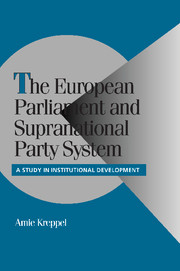Book contents
- Frontmatter
- Contents
- Figures
- Tables
- Acknowledgments
- 1 INTRODUCTION: THE EUROPEAN PARLIAMENT AND THE INSTITUTIONAL EVOLUTION OF LEGISLATURES
- 2 THEORIES OF LEGISLATIVE DEVELOPMENT AND THE EUROPEAN PARLIAMENT
- 3 THE DEVELOPMENT OF THE PARTY GROUP SYSTEM AND THE PARTY GROUPS
- 4 THE HISTORY OF THE EUROPEAN PARLIAMENT
- 5 THE INTERNAL DEVELOPMENT OF THE EUROPEAN PARLIAMENT: FROM COLLEGIALITY TO CONFLICT
- 6 THE DEVELOPMENT OF THE SUPRANATIONAL PARTY GROUP SYSTEM: CONFLICT AND COOPERATION IN THE COALITION FORMATION PROCESS
- 7 COOPERATION AND CO-DECISION: THE ROLE OF IDEOLOGY AND RULES
- 8 THE INTERNAL DEVELOPMENT OF THE SUPRANATIONAL PARTY GROUPS: AN ELUSIVE GOAL
- 9 CONCLUSIONS: UNDERSTANDING THE DEVELOPMENTAL PROCESS
- Appendices
- Bibliography
- Index
- Titles in the series
5 - THE INTERNAL DEVELOPMENT OF THE EUROPEAN PARLIAMENT: FROM COLLEGIALITY TO CONFLICT
Published online by Cambridge University Press: 18 December 2009
- Frontmatter
- Contents
- Figures
- Tables
- Acknowledgments
- 1 INTRODUCTION: THE EUROPEAN PARLIAMENT AND THE INSTITUTIONAL EVOLUTION OF LEGISLATURES
- 2 THEORIES OF LEGISLATIVE DEVELOPMENT AND THE EUROPEAN PARLIAMENT
- 3 THE DEVELOPMENT OF THE PARTY GROUP SYSTEM AND THE PARTY GROUPS
- 4 THE HISTORY OF THE EUROPEAN PARLIAMENT
- 5 THE INTERNAL DEVELOPMENT OF THE EUROPEAN PARLIAMENT: FROM COLLEGIALITY TO CONFLICT
- 6 THE DEVELOPMENT OF THE SUPRANATIONAL PARTY GROUP SYSTEM: CONFLICT AND COOPERATION IN THE COALITION FORMATION PROCESS
- 7 COOPERATION AND CO-DECISION: THE ROLE OF IDEOLOGY AND RULES
- 8 THE INTERNAL DEVELOPMENT OF THE SUPRANATIONAL PARTY GROUPS: AN ELUSIVE GOAL
- 9 CONCLUSIONS: UNDERSTANDING THE DEVELOPMENTAL PROCESS
- Appendices
- Bibliography
- Index
- Titles in the series
Summary
As Chapter 4 has clearly demonstrated, the European Parliament has only recently been successful in its long struggle for the attainment of true political power. A result of the EP's long history of legislative impotence has been a notable lack of scholarly interest in its internal development and organizational mechanisms, including the activity and interaction of the party groups. The earliest discussions of the Parliament consisted primarily of comparisons between the new institution and the national parliaments of the Member-States and tended, almost inevitably, to conclude that the EP was both politically handicapped and institutionally immature (Dehousse, 1967; Bubba, 1970; Fitzmaurice, 1978; Henig, 1979). There were some excellent descriptions of the party groups during the early years of the Parliament and during the run-up to, and immediately following, the first direct elections in 1979 (Van Oudenhove, 1965; Pinder and Henig, 1969; Fitzmaurice, 1975). The focus of these works, however, tended to be the traditional counting of parties and locating them along the left–right spectrum. Little was said about their internal development or their interactions with one another beyond noting their comparative weakness. Unfortunately, the failure of the EP to immediately become a significant political actor following direct elections discouraged further studies of both the internal structures of the EP and the party groups.
Even the best of the subsequent analyses of the European Union have generally included little more than a descriptive chapter about the EP (Dinan, 1994; Nugent, 1994). Modern analyses of the European Union very rarely delve into the internal operating procedures of the EP beyond a brief description of the hierarchical structures. No attempt is made to analyze how these structures have developed across time.
- Type
- Chapter
- Information
- The European Parliament and Supranational Party SystemA Study in Institutional Development, pp. 91 - 122Publisher: Cambridge University PressPrint publication year: 2001



